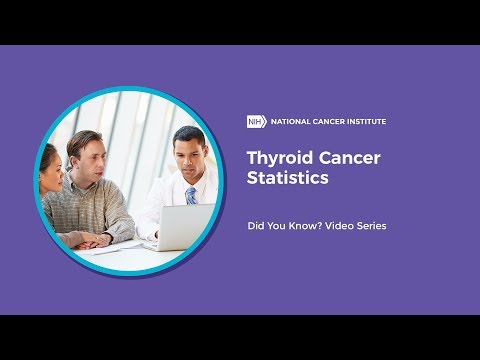After Rising for Decades, Thyroid Cancer Incidence Stabilizes
, by NCI Staff
After rising steadily for decades, the incidence of thyroid cancer in the United States may have stabilized, according to a new study. Although still increasing, the number off new cases has risen at a much slower rate in recent years than in the past.
The incidence of thyroid cancer in the United States began to rise during the early 1990s, with incidence in 2013 triple that of 30 years earlier. But the new analysis found that incidence began to level off in 2009 and remained relatively stable through 2012. The findings appeared April 14 in JAMA Otolaryngology-Head & Neck Surgery.
The reasons for the shift are not clear. The researchers noted, however, that the change occurred amid growing awareness among physicians and the public of the increased potential for detecting very small, slow-growing thyroid tumors that are unlikely to cause harm. The tumors, or nodules, are detected through screening and the use of technologies such as ultrasound.
“It’s becoming widely accepted that physicians are finding and diagnosing more small nodules in the thyroid gland that may never cause a medical problem,” said Luc G. T. Morris, M.D., of Memorial Sloan Kettering Cancer Center, who led the study. “We would never find these nodules by touch.”
A Changing Trend
Using data from NCI’s Surveillance, Epidemiology, and End Results (SEER) program, the researchers found that from 1988 to 1998, the incidence of thyroid cancer rose 3% per year. For the next 11 years, the annual increase was 6.7%. From 2009 to 2012, incidence still increased, but at a much slower rate—1.75% per year.
Not long after the study appeared, the SEER program released thyroid cancer incidence and mortality statistics for 2013, the most recent year for which data are available. The 2013 incidence was only slightly higher than the previous year.
“With the updated SEER data, the leveling-off trend remains rock solid,” said Dr. Morris. The incidence of small (less than 1 centimeter) thyroid cancers, which had been increasing at 9 percent per year, also stabilized, he noted.
The rapidly rising incidence of thyroid cancer in the United States “has been recognized as an ‘epidemic of diagnosis’ more than an epidemic of disease,” the study authors wrote. The detection of nodules that would never cause a medical problem is known as overdiagnosis.
“Overdiagnosis is important because it has consequences for the health of the patient,” said Barry Kramer, M.D., director of NCI’s Division of Cancer Prevention, who was not involved in the study. Consequences can include aggressive surgical treatment of indolent thyroid nodules, which does not benefit the patient, he explained.
“But overtreatment does expose the patient to the harms of unnecessary treatment, including major long-lasting side effects such as the loss of thyroid function, hoarseness, and low blood calcium levels, as well as anxiety and health costs,” Dr. Kramer added.
To address the problem of overdiagnosis, some professional organizations have issued guidelines for physicians about which nodules to biopsy. In 2009, for example, the American Thyroid Association issued guidelines that discourage the biopsy of smaller and more benign-looking nodules.
Reclassifying a Thyroid Tumor
Most recently, an international panel of experts reclassified a subtype of papillary thyroid tumor—removing the word “carcinoma” from its name—in an effort to reduce the treatment of these slow-growing, or indolent, tumors.
New cases of the subtype, known as noninvasive encapsulated follicular variant of papillary thyroid carcinoma, or EFVPTC, have increased in recent decades and now make up 10%–20% of all thyroid cancers diagnosed in Europe and North America, the panel wrote in JAMA Oncology on April 14. Noting that these tumors have a very low risk of adverse outcome, the panel proposed that they should now be called noninvasive follicular thyroid neoplasm with papillary-like nuclear features, or NIFTP.
The reclassification of these tumors is “a timely and appropriate change,” commented Kepal N. Patel, M.D., of New York University Langone Medical Center in an accompanying editorial. The new classification could affect the care and treatment of more than 45,000 patients around the world each year, he wrote.
The new classification, Dr. Morris said, is “one chapter in the bigger story” of trying to reduce the overtreatment of indolent thyroid tumors.
Incidence data from the next few years will determine whether incidence rates continue to be stable, Dr. Morris and his colleagues wrote. The trends will not only have ramifications for public health but will also determine “the appropriate level of aggressiveness in detecting and treating low-risk thyroid cancers,” they concluded.
